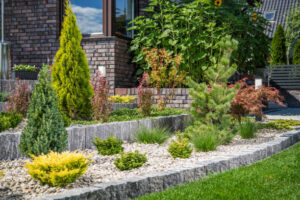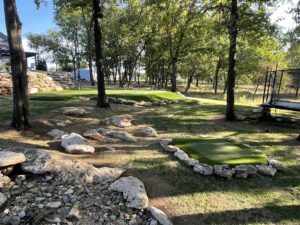Several factors go into successful landscaping Tulsa services from design to site preparation, planting, and mulch.
Each facet is vital to the success of new landscape beds and the long term sustainability of the completed work.
Carful inspection of the existing soil and sight area is vital to incorporating the necessary conditioners, fertilizers, and nutrients for beautiful landscapes.
This article will focus on landscaping Tulsa, soil preparation, proper planting techniques, and mulch application selections.
Soil preparation is one of the most important steps in the process of having successful landscape.


Young Backyard Rockery Garden with Small Plants. Residential Gardening Theme.
Many areas in Northeastern Oklahoma contain poor soil and require soil conditioners to be incorporated into the dirt to improve the composition and quality of the soil.
Cotton-burr compost is an excellent soil conditioner to use in heavy clay applications as it improves soil structure by breaking up the clay soil which helps extensively with prop water retention and drainage.
Another advantage of cotton-burr is the rich organic matter contained with in the cotton-burr.
Cotton plants steal the soil of all nutrients and stores the nutrients in the burr of the cotton.
This makes cotton-burr and excellent choice in improving the native soils found around homes in Green Country.
Generally, cotton-burr is disbursed 3” thick across the top of the landscaping beds and tilled deep into the soil providing nutrient dense organic compounds for the oncoming trees, shrubs, flowers and grasses.
You might think your done after preparing the soil, but many mistakes can be made during the planting phase of the landscape.
When planting, layout is an important piece to the ascetics and overall beauty of your landscape Tulsa services.
Additionally, proper care must be used when digging holes for your plants.
Generally, the hole should be twice the diameter of the root ball or pot. This breaks up the soil around the plant to speed up the establishment of the plant and facilitates proper root growth.
The depth of the hole should be no deeper than the base of the plant.
The importance here is keeping the plant from drowning and suffocating by securing the base of the plant above grade.
Next removing the plant from the pot(or burlap from the root ball) must be done with as little disturbance to the plant.
Many plants roots are highly sensitive to physical and mechanical distribution during the planting process.
Carefully set the plant in the middle of the hole and backfill with soil while gradually tamping the dirt around the plant to secure the base from the natural elements.
Finally, water the plant multiple times, this is not done to moisturize the plant but to remove the air pockets around the plant during installation.
Let the plant rest for a few minutes between watering to ensure all the air pockets are taken care of and a nicely watered plant is ready for growth.
Now the landscaping Tulsa is nearing completion, yet one final step is necessary to finish the landscape, retain moisture, and reduce unwanted growth.
You may have already guess what was coming next, but did you realize the need and importance of mulch?
Yes! I said mulch!
Mulch is an underrated aspect of landscaping.
It provides many benefits such as moisture retention, aesthetically beauty, and as a barrier to unwanted weeds.
The conservation of moisture is the most important aspect of mulch.
It reduces the maintenance cost of landscape, maintains the necessary moisture content of the soil, which in turn improves the health and fertility of soil, and reduces the environmental footprint of the landscaping.
The overall beauty of the landscape is also greatly increased as the much provides an even canvas and base for the flowerbeds.
Mulch covers imperfections in the dirt and contours of the ground and its acts as the caulk and paint of finishing a house.
Further, mulch acts as a natural barrier to unwanted weeds, plants, and grasses.
A well mulched landscape won’t completely remove the growth of unwanted plants but will greatly reduce the amount of time and energy spent pulling weeds.
The types of mulch used in landscaping Tulsa services also depends on the plants and desires outcome.
Acid loving plants such as Azaleas and Gardenias need pine needles or pine bark much to be successful. The mulch leaches acid into the soil as it decomposes which in turn feeds the roots of the acid loving plants.
Non-acid loving plants, such as Boxwoods and Holly’s, will thrive with all other types of much.
The number one mulch in the market today is Grade A Cedar mulch or sometimes referred to as All Bark Mulch.
It does well in every setting as the make up of the tree fibers grip tightly together and aren’t affected by water.
 This is great since Grade A won’t blow out of flowerbeds and it doesn’t float during heavy periods of rain so you can be assured that the mulch you put down won’t be wasted into your yard.
This is great since Grade A won’t blow out of flowerbeds and it doesn’t float during heavy periods of rain so you can be assured that the mulch you put down won’t be wasted into your yard.Rock mulch is becoming a popular permanent alternative to wood based mulch as rocks don’t deteriorate and stay where you place them.
River rocks are generally a greater investment but you won’t have to add rocks season after season saving you money in the long run.
Following these tips, you should have a better understanding of what goes into successful landscapes.
With this knowledge the necessary tools are at your fingertips to find a landscaping Tulsa company that truly has your landscape best interest at heart.
You can use your new found awareness to successfully quiz your prospective landscapers about their knowledge and make a wise decision on who you trust to handle your landscaping needs.
